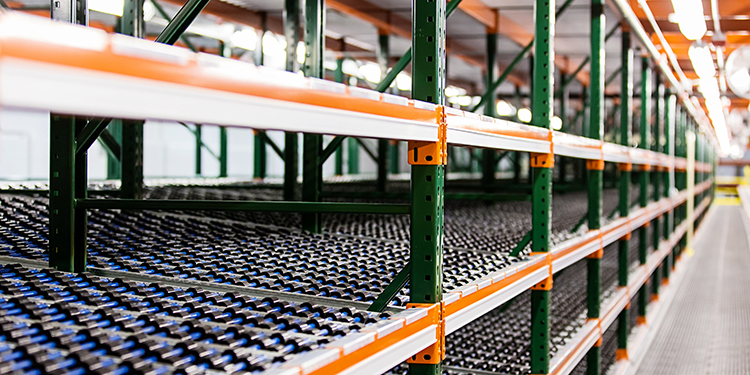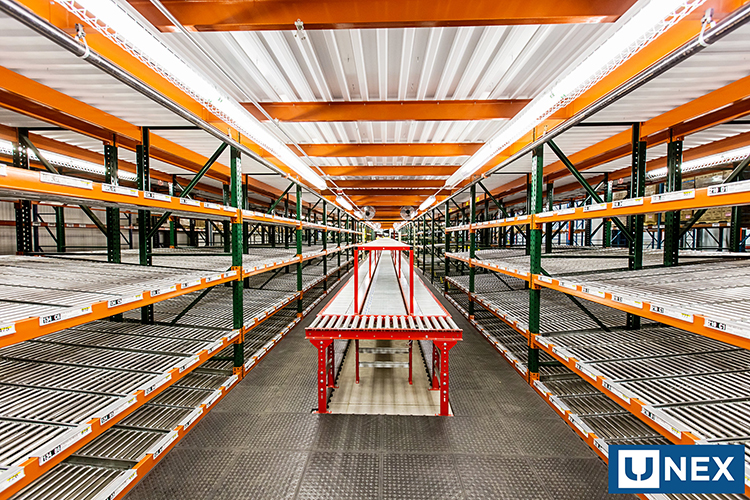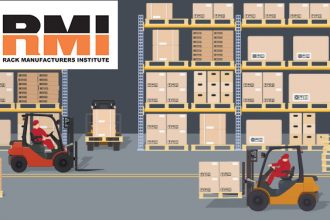Learn How Converting Static Pallet Rack To Carton Flow Improves Ergonomics In E-Commerce Picking

With projections estimating that the North American e-commerce market will multiply at a compound annual growth rate (CAGR) of 12.5% between now and 2027, it is increasingly likely that facilities configured to primarily handle pallets will need to shift to picking more eaches. While it’s certainly possible for warehouse and distribution center (DC) staffers to pick individual stock keeping units (SKUs) from cases stored on static pallet rack or shelving, it’s not especially ergonomic. Fortunately, there’s an easy solution: carton flow. Here, we explore how converting pallet rack to carton flow improves ergonomics in e-commerce picking.
What is Carton Flow?
As detailed in Considerations for the Planning and Use of Industrial Steel Storage Racks, published by the Rack Manufacturers Institute (RMI), carton flow lanes or shelves are a pallet rack accessory. The document defines them as follows:
Carton flow lanes consist of flow tracks that are installed to flow small, hand-loaded packages from the front to the back of a rack bay. These can be track assemblies that mount to the beams or a fabricated shelf assembly that is used for the same purpose. The tracks can include wheels or rollers.
“To convert static pallet rack for each picking, carton flow installs directly into existing rack structures. This creates a dynamic storage system that dramatically improves accuracy, maximizes space, and minimizes strain on workers,” said Megan Baker, Director of Marketing at UNEX Manufacturing. UNEX is a member of the Ergonomic Assist Systems & Equipment (EASE) Council.

Leveraging the force of gravity, cartons of product loaded from the back advance forward with no manual intervention required. This loading methodology supports first-in/first-out (FIFO) inventory management, making carton flow ideal for ensuring proper stock rotation, Baker added.
Carton Flow Options
Similar in concept to (but smaller in scale than) pallet flow systems, carton flow tracks or beds incorporate metal or plastic rollers or skate wheels. Roller-style carton flow comes in fixed lane configurations that match a specific product or carton width. This is ideal for e-commerce operations handling consistently sized items, like shoe boxes.
Wheel-based carton flow allows multiple, variable-width cartons to sit side-by-side with no gaps in between, maximizing space. This style is ideal for operations handling a broad variety of products, such as those fulfilling health and beauty product orders. It’s also a good choice for third-party logistics (3PL) solutions providers whose client rosters rotate with relative frequency.

Better Ergonomics Reduces Injury Risks
Carton flow systems improve ergonomics by reducing the risk of musculoskeletal injuries, Baker explained.
“Because cases of product loaded into carton flow systems automatically roll forward, associates can easily access the contents for each picking. Conversely, cases stored in static pallet rack shelving do not advance to the front of the shelf. Instead, the associate must reach into the rack to pull the case forward—requiring physical exertion,” she said.
The automatic advancement of cartons eliminates ergonomic strains associated with stretching, straining, climbing, pushing, pulling, bending, or twisting. Instead, a new case of items appears at the pick face when the picker removes the empty one ahead of it.
“Musculoskeletal injuries most often result from the cumulative effect of repetitive stresses or strains, like those associated with picking from static shelving,” Baker noted. Indeed, the Occupational Safety and Health Administration (OSHA) says that 60% of work-related musculoskeletal disorders are caused by on-the-job injuries that result from poor ergonomics.
Eliminating Awkward Picking Positions
Further, Liberty Mutual Insurance’s Workplace Safety Index reports that non-fatal workplace injuries cost U.S. businesses in the retail industry (including e-commerce order fulfillment) more than $5.25 billion annually. Of those, improper ergonomics when handling objects or by assuming awkward postures are responsible for more than a third of those costs.
“Carton flow designs can also incorporate an additional angle at the front, or picker end, of the system. This causes the case to safely tip forward,” said Baker.
She noted that the additional angle improves both visibility and pick accessibility. “Tipping the case to face the picker further enhances ergonomics. That’s because the associate does not have to bend their wrist at an awkward angle to reach into the case to pick the contents.”

Reducing Travel Time Cuts Fatigue
By making cases continuously available at the pick face, carton flow significantly reduces the amount of time an associate must spend searching for each item. Carton flow also increases storage density, explained Baker.
“Carton flow can increase an operation’s space utilization for picking by 50% or more, depending on the situation,” she said. “It allows facilities to utilize more space within the racks to store SKUs compared to static shelving. Shelving typically creates a lot of unreachable areas, also known as ‘dead zones.’”
Further, carton flow reduces the overall footprint of an order picking operation, which cuts travel time between picks. This can boost efficiency by as much as 30%, Baker added.
“Ergonomically speaking, less time spent walking also reduces associate fatigue. When employees aren’t as tired on the job, their picking accuracy improves along with their ability to pick more items per hour,” she concluded. “Notably, all of these ergonomic benefits associated with adding carton flow to pallet rack improve operational productivity.”
Looking for more ways to adapt existing pallet rack for ergonomic e-commerce picking? Purchase RMI’s Considerations for the Planning and Use of Industrial Steel Storage Racks.


